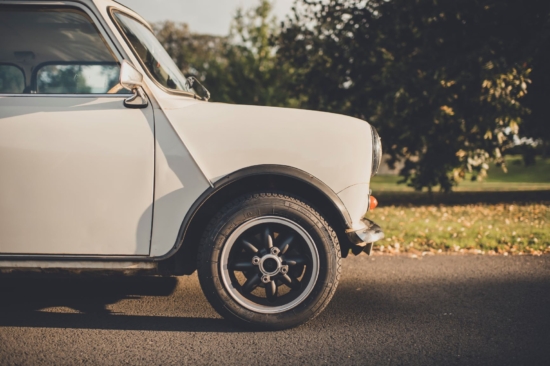Pirelli launches vintage Cinturato CN54 for classic Mini collectors
 Pirelli has revived the Cinturato CN54 design with updated technologies
Pirelli has revived the Cinturato CN54 design with updated technologies
The latest Pirelli Collezione tyre targets owners of the legendary Mini. The tyre is produced for the many versions of the classic Mini, including the cars built under licence by Innocenti; Pirelli has recreated the Cinturato CN54, originally launched in 1972, in the size 145/70 R12. The manufacturer’s vintage tyre range is designed for iconic cars built between 1950 and 1980, uniting vintage looks and modern technology. Read more about the history of Mini tyres on Tyrepress and WhatTyre.
The new radial tyre has a tread pattern and sidewall design similar to the original. However the tyre also includes the latest compounds to offer increased grip and improved road holding on wet surfaces, improving reliability and safety standards. Pirelli’s engineers worked with the original parameters of the original vehicle designers to complement the suspension and chassis settings of the Mini as new. They referenced materials and tyre designs housed in the Pirelli Foundation archives in Milan.
Pirelli and Mini
Pirelli designed its first Mini Cinturato tyre with a tread pattern named 367F in 1964. One year later, the Mini’s success reached Italy and Innocenti obtained a licence to produce the cars in its Lambrate factory near Milan, with production continuing until 1975. In 1976, Pirelli developed tyres for the Mini 90 in 145/70 SR12 size and Mini 120 in 155/70 SR12 size.
For the sporting versions of the car, such as the Innocenti Turbo De Tomaso, Pirelli made its special “wide series”: radial tyres with a wider tread pattern and lower sidewalls compared to traditional rubber. In the 1980s Pirelli made the P3 for city cars –equipping the entire Mini family including the Red Flame, Check Mate, Studio 2 and Piccadilly special editions. Mini was reborn in 2000 under BMW’s wing, and Pirelli homologated the Eufori Run Flat tyre for the new car. The tyre was able to drive 150km at a maximum speed of 80km/h even when completely flat.
The “fabulous new tyre with its own safety belt inside” was how Pirelli described the Cinturato when it was launched, a radial construction tyre that went on to equip some of the world’s most significant cars for more than 70 years.
The Pirelli Collezione family was born with the goal of preserving automotive history through tyres that serve a dual yet complementary purpose: maintaining the look and driving feel of the original versions but improving efficiency and safety thanks to modern technology and production processes. The range is filled legendary names, from the Stella Bianca, first launched in 1927, to the Stelvio, as well as the more recent Cinturato P7 (1974), P5 (1977), P Zero (1984) and P700-Z (1988). The images, plans and other materials supplied by the comprehensive Pirelli Foundation archive played a fundamental role in reproducing these tyres. The Foundation has kept all documents relating to the design, development and production of every Pirelli tyre over the years. Pirelli Collezione tyres are available from specialised classic car tyre dealers, such as Longstone Tyres, as well as from Pirelli’s flagship P Zero World stores in Los Angeles, Munich, Monaco, Dubai and Melbourne.
The Mini Minor 850 was the first model designed from scratch by the British Motor Corporation and it was initially sold by two different brands: Austin and Morris. It had two different names to match: the Austin Seven and Morris Mini-Minor. The car was designed by Alec Issigonis as everyday transport, but its application for motorsport was soon spotted.
In 1961 the first Mini Cooper appeared, which triumphed in Rally Monte-Carlo two years later. This was the era in which the ‘minicar’ phenomenon had well and truly arrived in Italy as well, with room for manoeuvre and parking spaces in short supply compared to the number of cars on the road. This caused something of a conceptual re-think of the way cars were designed. Production of the Mini in Italy began with the Mini Minor 850, before moving onto the Cooper 1000 and then eventually the Mk2, Mk3, Mini 1000 and Mini 1001.
The Italian versions of the Cooper met with great success, as they offered better trim levels than the British versions at a lower price. As the 1970s approached, British Leyland (the successor to BMC) took two decisions. Firstly, they were going to turn Mini into a distinct stand-alone brand, and secondly a new Mini Clubman luxury version would be introduced. In 1984, there were various mechanical modifications, such as front disc brakes, to keep the car up to date. By 1997, the Mini name had been acquired by BMW. In 2019, Mini celebrated the brand’s 60th anniversary, with the exclusive Mini 60 Years Edition introduced.



Comments